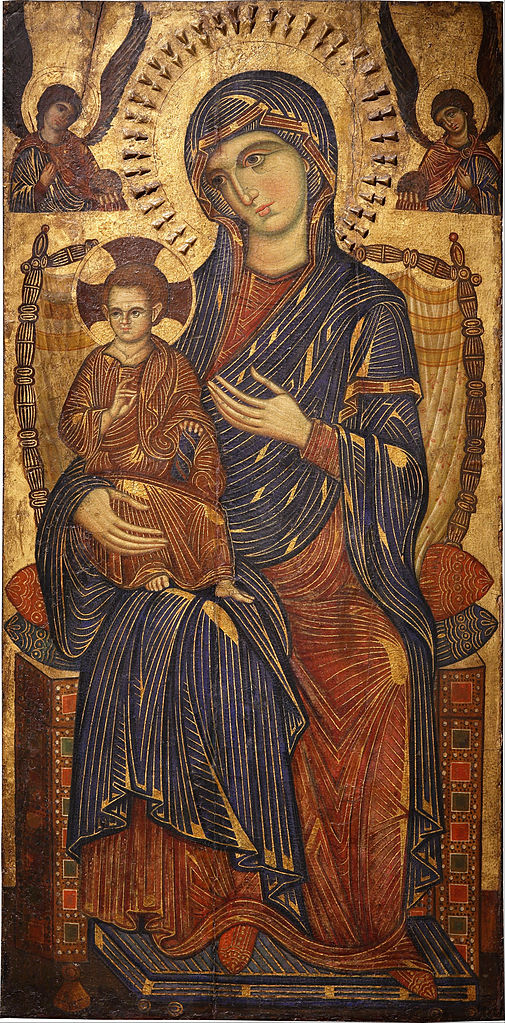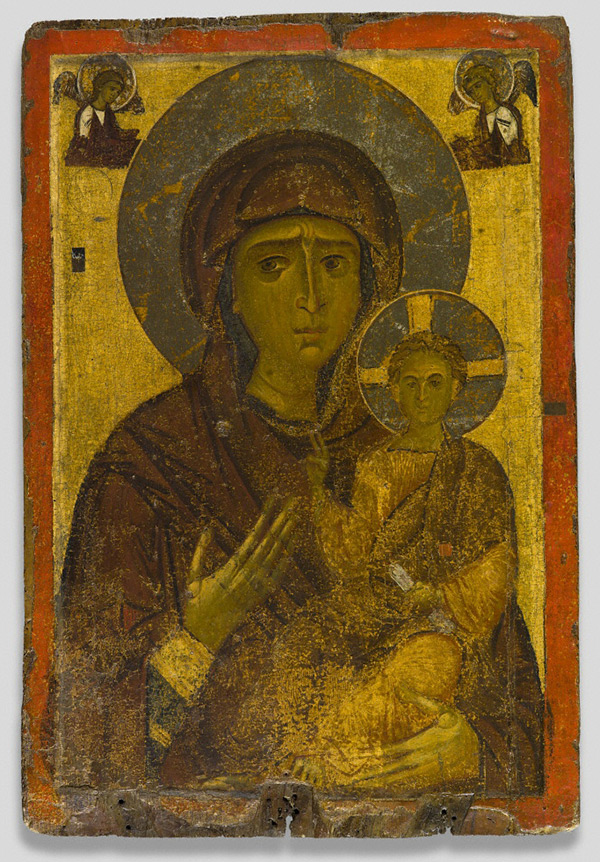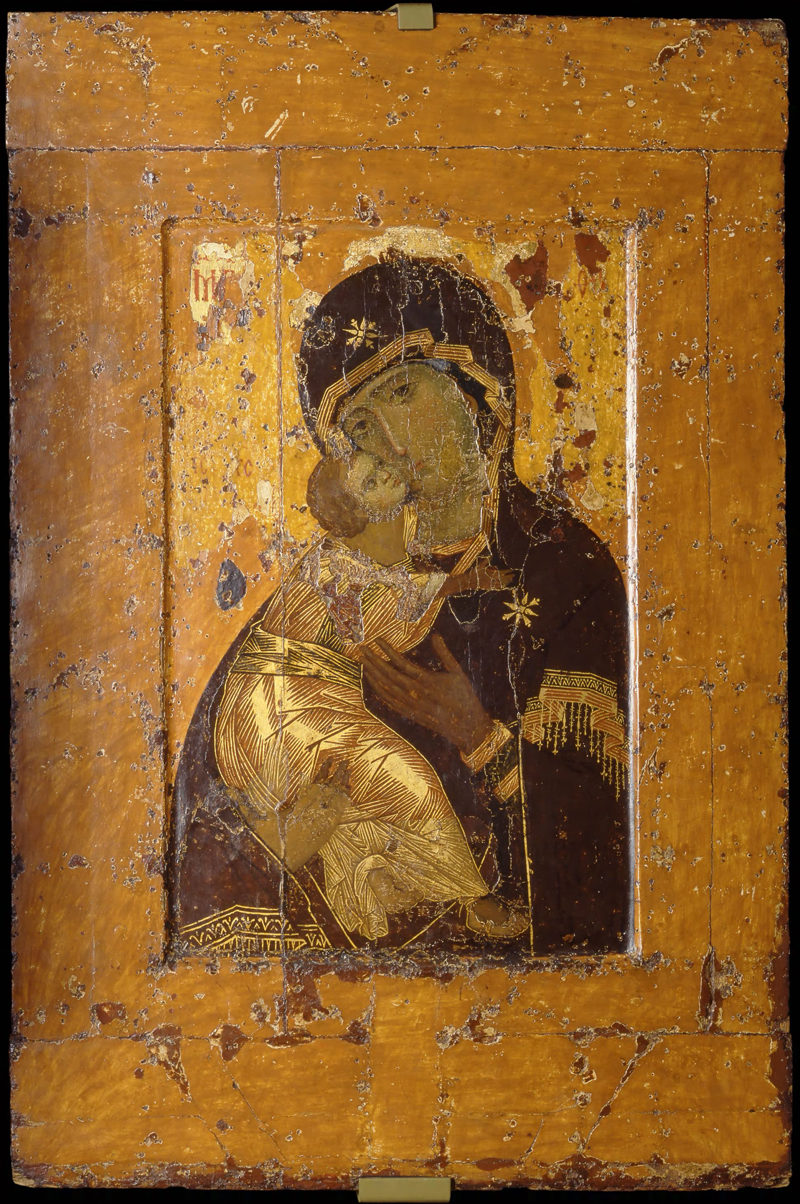Part 9 – Seeing the Good News
Above: The Vladimir Mother of God (12th century)
“I’ve stopped watching the news,” my friend tells me at a holiday party. Having taken a challenging new job, this one move to consciously shut out media on his phone and his TV has reduced his stress significantly he says. I know exactly what he’s talking about. I made the same decision almost 15 years ago when as a new mother faced with the challenge of caring for our first child who had been born premature. Watching the news isn’t a bad thing, and we do need to be aware of what is happening in our country and the world. We live in a culture that often voices opinions and feelings concerning the events and issues facing the world today. It’s easy to hear about natural disasters, violence, injustice, etc. Just scrolling through my Facebook feed gives me a pretty good idea of what is going on. I may pop onto a news site for more information, but then I’ve got to put it in the hands of God. Jesus himself told us what to expect in our own lives and in the world beyond us:
I have told you these things, so that in me you may have peace. In this world you will have trouble. But take heart! I have overcome the world. – John 16:33
We stand once again at the crossroads of a new year. Time to take stock of where we’ve been, and where we might go. Remember back in Part 1 when I told you about Marie Kondo’s approach to cleaning your closet? Her method for whittling down your possessions to those you value and use most is appropriate for other aspects of our lives as well, like what we will place before our eyes, what we will pause to ponder. There is surely enough drama going on in the world that you could watch news media all day long listening to various politicians, leaders, and other famous individuals hash it out, OR you could chose to turn your attention to the pondering of other stories…
There’s a New King in Town

Madonna and Child Enthroned (13th century), Italian panel painting. Pushkin State Museum of Russia.
After Jesus was born in Bethlehem in Judea, during the time of King Herod, Magi from the east came to Jerusalem and asked, “Where is the one who has been born king of the Jews? We saw his star when it rose and have come to worship him.”
When King Herod heard this he was disturbed, and all Jerusalem with him…
Then Herod called the Magi secretly and found out from them the exact time the star had appeared. He sent them to Bethlehem and said, “Go and search carefully for the child. As soon as you find him, report to me, so that I too may go and worship him.”
After they had heard the king, they went on their way, and the star they had seen when it rose went ahead of them until it stopped over the place where the child was. When they saw the star, they were overjoyed. On coming to the house, they saw the child with his mother Mary, and they bowed down and worshiped him. Then they opened their treasures and presented him with gifts of gold, frankincense and myrrh. – Matthew 2:1-3,7-11
Move over Herod! There’s a new king in town and there is nothing fake about this news. When it comes to stories the public deserves to hear, it’s the one above. This week on Epiphany (always January 6) or Epiphany Sunday (the Sunday following January 6), Christians around the world will have opportunity to hear the account of the Magi visiting Jesus and his family. This is the time to celebrate the revelation of Christ to the Gentiles/world as represented by the Magi’s visit.
There’s a legend that says these same Magi who came from afar had among them an artist and this individual was tasked right there while the foreign astrologers stood in awe of the boy-king to paint a portrait of the child on his mother’s lap. Perhaps the travelers did return home with an image of the king whose star had guided them. It would have been an appropriate memento of such a rare and awesome experience…and such great news!
Sharing the Good News
Old icon depicting Luke painting Mary holding Jesus.
You may remember, as I do, being told the meaning of the word gospel – it’s the old English word for “good news”. There’s a story associated with Luke’s writing of the good news for Theophilus, the gentleman for whom he wrote his gospel and book of Acts. There is a very old legend saying he included also a portrait of Jesus as a boy on Mary’s arm (a visual testimony of Jesus’ life on earth) when he delivered his account. It is said that Mary herself sat for the portrait (though not with the child as this painting would have been done after Jesus had died, risen and ascended to heaven). Upon it’s completion, Mary approved saying, “My blessing will remain always with this icon.” Several images today are claimed to be the original painting by Luke though all have seemingly been painted over or reworked in efforts to preserve them.

Icon with the Virgin and Child, 1175–1200, made in Greece. Egg tempera on wood with gold leaf, 45 1/4 x 30 1/2 in. Image courtesy of the Byzantine Museum, Kastoria, no. 457
The image Luke rendered had some unique “good news”-proclaiming features which I feel makes the possibility of such a portrait included with a gospel text that much more believable. This composition is known as the Hodegetria or “She Who Shows the Way”. These images are characterized by:
- Jesus as a boy or small man sitting on Mary’s arm
- Mary gazing directly at the viewer or away from Jesus as though deep in thought
- Mary’s free hand gesturing towards the Christ-child
- Christ gazing at the viewer
- Christ gesturing a blessing with one hand and holding a scroll representing His message of salvation and love to mankind
- Both figures wear a halo, also called a nimbus – the Christ-child’s wears a distinctive cruciform nimbus (a cross is featured in his halo)
- Christ wears a sunny golden-orange garment indicative of being “the light of the world”
- Mary wears a reddish brown cloak over a blue dress, a look reserved just for her in icons
- Many depictions place 3 golden stars on Mary at her head and shoulders symbolic of her virginity before, during and after her carrying the Christ-child
It has been articulated that Mary’s gaze asks the viewer one simple question:
Do you know my Son?
Variation on a Theme

The Vladimir Mother of God (12th century)
Over the centuries artists have given expression to variations on the Hodegetria model. One of the most beloved among Christians has been the version known as “Mother of God of Tenderness” or “Mother of God of Lovingkindness”. These express something of the loving bond between a mother and child. Tenderness icons further highlight the humanness of Christ. Mary seems often a bit more sad, symbolic of the prophecy she received: “And for you…your very soul will be pierced by a sword.” (Luke 2:35) Russian believers and icon artists found this variation quite captivating:
It is one of the summits of Russian art. Neither French Gothic art nor the Italian Renaissance managed to put into this image greater warmth. They created images that were more human, but not more moving. The Russian icons of ‘Lovingkindness’ justify their name, for looking at them the spectator is moved by a feeling of deep lovingkindness… ‘a man’s heart burns for all creation – men, birds, animals, demons and all creatures. At their memory and sight his eyes shed tears. Great and powerful compassion fills a man’s heart, and great suffering wrings it, so that he cannot endure, hear or see any harm or the least pain suffered by a creature. This is why he prays hourly, with tears, for…creation, for the enemies of the truth, for those who harm him, that they should be preserved and shown mercy… – V. N. Lazarev, 1947
The most celebrated icon of this “Tenderness”/“Lovingkindness” genre is The Vladimir Mother of God (pictured above), a national treasure of the Russian people to this day. It was said to have originated in Constantinople and was brought from there to Russia in 1155. It was carried into battle by the Russian army on many occasions over the centuries and it’s every move has been carefully documented. Today it can be seen in a chapel on the grounds of the the Tretyakov Gallery in Moscow.
Final Thoughts
Let’s bring this back around to our discussion of the Reformation for a sec…
If we zoom in on what was happening in Europe circa Martin Luther’s day, we see a papacy and nobility focused on procuring enough funding to support their sumptuous living and power-seeking urges. This naturally laid the burden on the backs of the people beneath them. The masses were told new stories of ways they could secure the salvation of themselves and those they loved in the eternal realm beyond: You must buy indulgences! It was blatant scam that had Luther steamed. Yet, he was powerless to refute such campaigning without the Scriptural proof and God-given insight to understand salvation differently. Our God, He is faithful, and soon Martin found what he had been seeking – a single verse in Romans whereby we can understand the simplicity of the gospel message.
For in the gospel the righteousness of God is revealed – a righteousness that is by faith from first to last, just as it is written “The righteous will live by faith.” – Romans 1:17
What we can see in an icon such as the Vladimir Mother of God is, as Jim Forest attests, “the profound oneness uniting Mary and Jesus.” (Praying with Icons, p. 113) Here we have a wonderful model of the tender relationship we too may experience with the Savior. As Luther came to understand, it is only a matter of us receiving Christ through the unlimited riches of God’s grace. To gaze on such an image while holding this truth can be transforming.
2017 was a challenging year for me, it took some twists and turns I clearly wasn’t expecting or prepared for, and that has me looking at the future with the perspective to even further reduce or eliminate sources of stress:
- activities or involvements that bear no fruit or promise of fruit
- relationships not grounded in love and mutual respect
- unreasonable or unhealthy expectations placed on me by myself and others
- routines, habits and practices which do not enhance healthy and faithful living
While I routinely am looking at art, I haven’t made this a part of my daily routine for quite some time. So my one addition for the future will be “watching the daily GOOD news” – which is lingo meaning to spend time contemplating works of art intentionally and regularly. This also has me thinking a bit clearer about the art I am planning to make in conjunction with this blog series. I’d like to make pieces that have a contemplative bent to them, making them easy to welcome into one’s life and home – as simple as turning on the TV. Stay tuned!
I found the following source of great value in writing this post:
The Meaning of Icons (1999) by Leonid Ouspensky and Vladimir Lossky
Down an Ancient Path
The BIRCH TREE STUDIO BLOG
